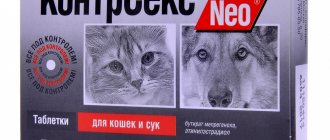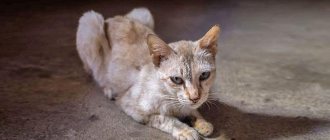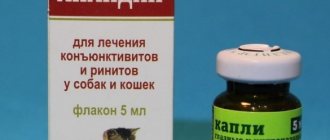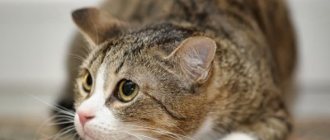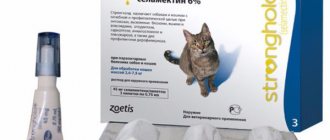What is it for?
Your pet's ears constantly produce sulfur, a substance that protects the canals from dirt, parasites and other bacteria. However, there is often an excess of it, which the cat is not able to get rid of on its own. In this case, she needs help from the owner. If you leave things to chance, then later you can “get” a pet with wax plugs, otitis media or even mites.
Chlorhexidine and furatsilin solution for care and rinsing of eyes for cats
What is needed and the price for what is needed
A cotton pad is used to clean the ears. There is no need to use cotton swabs - they can cause serious damage. Gauze is also not suitable as it can damage soft tissue.
Before wiping the ear, the cotton pad must be moistened with lotion or other disinfectant. There are many options for cleaning.
Cat ear cleaning lotion
Cleaning lotion
The most affordable and popular product for this hygiene procedure. Another plus is the wide range of products. Most often, it is the lotion that pet owners choose as a means for treating their pet’s ears.
The price range is 150-700 rubles per package.
Ear hygiene drops
Drops
Ear hygiene drops are less common than lotion. In most cases, drops are a veterinary drug for the treatment of fungal and parasitic diseases. However, there are also disinfectants that leave no traces behind.
Ear drops contain substances that dissolve wax and other contaminants in the ears. As a rule, such products are used regularly, including after long walks or after bathing at home. The price for them is about 1200 rubles.
Cat ear powder
Powder
Powder is a means for regular treatment; its properties help eliminate itching and other unpleasant sensations in your pet. Bactericidal powder is very often used by owners of show animals.
The product is often recommended by veterinarians for treating ears during inflammatory processes. The average cost is 200-500 rubles.
The powder is also used to remove large amounts of hair on the inside of the ear. To do this, it is applied to the hairs and smoothly distributed with a cotton swab. After this, the hairs are pulled out, and the remains are carefully removed with a cotton swab. Antibacterial powder is more often used by dog owners than by cat owners. This product is one of the favorites among animal groomers.
Cat ear cleaning gel
Gel
There are so-called gels for cleaning the ear canals of cats. Their peculiarity is that they form a liquid upon contact with the skin, washing away all the dirt from the ears. After use, the gel does not leave any greasy stains.
To achieve greater effectiveness, apply the product to a cotton pad and wipe the pet’s ears with it. To clean the hearing aid, a small amount of gel is squeezed into it.
After this, the ear must be massaged. The pet itself will push all the dirt out; they are removed with a dry cotton pad.
Cleansing gels are rare and require significant expense. For 100 ml you will have to pay about 500-700 rubles.
Spray used to clean ears
Spray
Sprays are used not only for preventive purposes. Their use is prescribed by veterinarians if a pet is diagnosed with otitis media and other inflammatory processes in the ear.
The product contains substances that dissolve sulfur and other dirt. They also normalize the condition of the skin and have an anti-inflammatory effect.
The use of the spray is practically no different from other drugs. First, it is applied evenly throughout the ear, which is then gently massaged. The intensity of the massage depends on the general condition and pain. Then use a dry cotton pad to remove dirt from the inside of the ear.
Hygienic sprays rarely appear on the windows of pet stores and veterinary pharmacies. However, they are not expensive. Their average cost is 150-250 rubles per 100 ml.
Napkins
Wet germicidal wipes are very easy to use. They already have all the necessary substances for cleansing. It is enough to wrap your finger in them and carefully remove wax and other dirt. The wipes have antiseptic properties and gently cleanse the sensitive skin of the ear.
Wipes are available for the ears and eyes of cats. The availability and convenient use of this product makes it an ideal option for those who like to travel long distances with their pets. The price of napkins is completely different: for a package of 15-20 pieces you can pay 20-200 rubles. Packages with a large number of napkins are significantly more expensive: they are sold for both 200 and 700-800 rubles.
Battery operated ear cleaner
Special gadget Ear cleaner
Special ear cleaning devices are suitable not only for adults, but also for small kittens. The device is equipped with a backlight and a silicone nozzle that reliably removes all accumulations of sulfur.
The nozzle is specially made in the form of a spiral to reduce the likelihood of injury to zero. It also ensures the safety of the procedure even for small pets: kittens, puppies and rabbits. After use, the nozzle is thoroughly rinsed under warm water.
The device is gradually gaining popularity. It is not sold in all pet stores.
On average it costs about 150-1000 rubles. As a rule, the kit already includes one battery.
What are the most effective remedies for ticks: drops, ointments or folk remedy therapy?
Finding a cure for ticks will not be particularly difficult.
To do this, you can use drops, ointments, folk remedies:
- drops on sale. You can choose a medicine for kittens, pregnant cats or elderly animals. One of the advantages of drops is ease of use.
- Ointments are the main medicine. Their range is not so wide, but they last much longer, which prevents the further spread of the mite deep into the ear. The disadvantage of ointments is that they are difficult to apply.
- Folk remedies . It is easy to prepare medications at home, but experts insist that it will not be possible to eradicate the parasite using folk remedies; it will only waste time. The best you can hope for is a reduction in the insect population.
At the initial stage of infection, it is recommended to use drops, and at an advanced stage, additional ointments should be used. Folk remedies are suitable for preventing infection during dangerous periods of the year.
How often should you clean at home?
The frequency of treatment depends on the breed and size of the cat's ears. Unlike cleaning your dog's ears, experts do not recommend rinsing more than once a week, so as not to wash away the natural protection against bacteria and parasites.
Representatives of breeds similar to wild cats, such as Bengal, British Shorthair, LaPerm, Siamese, British Chinchilla, Kurilian Bobtail, Ocicat, as a rule, do not have problems with self-cleaning their ears.
Individuals with large ears are more susceptible to pollution. These include, first of all, Donskoy, Canadian Sphynx, Kohana, Bambino, Dwelf, Minskin, Elf, Ukrainian Levkoy and other hairless cat breeds. If you disinfect them in the morning, then by evening you may notice new discharge.
For a number of breeds, the ears are the most vulnerable place. This includes the Scottish Fold cat. Its unique folded ears endow the wearer with beauty, but at the same time increases the risk of inflammation. The frequency of procedures for Scottish Folds is the same - once every 7 days, but the ears need to be checked much more often.
If your pet’s ears rarely get dirty, then the number of treatments can be reduced to once every 2-3 weeks. Only in rare cases are they left untouched for a whole month.
Carefully place special drops in the cat's ear
How to use various remedies for ear mites in cats
Before using medicinal drops, it is recommended to first clean the inflamed ear from scabs, then drip 3-5 drops of the medicine into each ear. If necessary, therapy should be repeated after 5-7 days.
Attention! Even if only one ear is inflamed, the drug is still injected into both.
In case of severe damage, the method of application is to treat every other day until the unpleasant signs of infection disappear.
Training
It should be remembered that cats are not very favorable towards this procedure.
More wayward pets may experience outbursts of aggression and endless attempts to escape from their hands. Therefore, the owner must first accustom the kitten to ear treatment so that it is not associated with danger.
To prevent your pet from experiencing stress every time, you need to play with him before treatment. After the procedure, the cat is rewarded with a treat. In this way, the owner reinforces the positive aspects before and after ear cleaning. This means that the ward will have no reason to panic in the future.
Process
Before starting, it is important to properly secure your pet. To do this, the cat is picked up and placed on the knees sideways. To avoid sudden movements on the part of the pet, cover it with a towel. After this, the ear is carefully moved to the side and examined.
If there is contamination, then it must be removed. Depending on the product, it is applied to a cotton pad (tampon) or dripped directly into the ear canal. If necessary, the ear is massaged, and then all discharge is removed from it. If gel was used, the pet will remove its remains on its own. The owner removes the remaining powder.
Processing is carried out according to the principle of “outward movement” and not vice versa. Otherwise, careless actions will only push the sulfur deeper. Manually treating the ear canal is not recommended. Ears are a vulnerable part of a cat’s body and the owner can easily damage them with his hands. If there is a need to use a cotton swab, then it is inserted no deeper than 1-1.5 cm.
Even the calmest cat can panic. If this happens, it is better not to hold your pet forcibly and give him freedom without increasing stress. The procedure is postponed until the next day or for some time.
Medicines for otitis media
Treatment of otitis is carried out using systemic and local drugs. The prescription list includes medications recognized in veterinary medicine. Basic therapy can be supplemented with traditional medicine. To achieve a positive result, it is important to follow the treatment regimen and duration of the course prescribed by the veterinarian.
Medicines of official medicine
To sanitize the auricle and external auditory canal, use sterile gauze wipes soaked in an antiseptic solution. Boric acid (3%), chlorhexidine, hydrogen peroxide (3%), furatsilin, miramistin are suitable for this purpose. If the eardrum is not damaged, then drops for otitis media can be used for treatment:
- Sofradex;
- Dexamethasone;
- Aurikan;
- Uricin;
- Surolan;
- Anandin;
- Otibiovet;
- Tsiprovet;
- Tsipam;
- Otovedin.
Otibiovet
The medicine comes in the form of clear drops. The dropper bottle can have different volumes - 20, 30 or 50 ml. The drug is used for otitis of the external and middle ear. Active substances (gentamicin sulfate, triamcinolone acetonide, salicylic acid, carbetopendicinium bromide) act against bacteria and fungi. Drops reduce itching, discharge, and reduce the manifestations of dermatitis.
Surolan
An oily suspension containing miconazole nitrate, polymyxin B sulfate, prednisolone acetate. This is a combined drug that has anti-inflammatory, antibacterial, fungicidal, and antiallergic effects. The volume of the bottles is 15 or 30 ml.
If otitis in cats is caused by bacteria or they are a secondary cause of inflammation, systemic antibacterial drugs are prescribed. The use of these medications is also justified for fungal otitis in order to prevent infection by bacterial microflora. The list includes:
- Amoxiclav;
- Ampicillin;
- Amoxicillin;
- Cefazolin;
- Ceftriaxone;
- Cefixime;
- Erythromycin;
- Clarithromycin;
- Azithromycin;
- Spiramycin.
Ampicillin
global $ads_google; //data-ad-slot=”2475549904″ $ads_google = empty($ads_google) ? false : true; ?> if ($ads_google == false) {?>
$ads_google = true; ?> } ?>
Semi-synthetic drug of the penicillin series. Available in the form of tablets and powder for suspension. The medicine has a broad antimicrobial effect. The tablets are given to the cat on an empty stomach or 2 hours after eating.
Cefixime
Semi-synthetic antibiotic from the group of cephalosporins in tablets or powder. Active against many pathogenic bacteria. Used to treat otitis media in the acute stage. Not suitable for small kittens and sick elderly pets.
To treat integuments affected by parasitic fungi, fungicidal ointments are used: Panolog, Oridermil, Clotirmazol, Nystatin. In some cases, MycoStop ProVET antifungal drops are indicated. Complex therapy includes vitamin-mineral complexes and immunomodulators (Imunofan, Ribotan). They help the cat's body resist infection.
Folk remedies
Additional support for otitis media in cats is also provided by traditional medicine recipes. They are easy to prepare and use at home. The most harmless solution is considered to be a solution made from strong green tea. The filtered tea leaves are used to wipe the cat's ears. This product has a disinfectant and acaricidal effect. An infusion of herbs with antibacterial and anti-inflammatory effects has a similar effect. Chamomile, string, lavender, birch leaves, and St. John's wort are suitable for processing.
Errors
Inexperienced owners can make a number of mistakes. Cats themselves do not like encroachments into their comfort zone, and if this is done rudely, it can provoke panic in the pet. Animals have associative thinking and one unsuccessful attempt is enough for the procedure to forever turn into a terrible event.
Is it possible and how to rinse a cat’s nose with saline solution?
Careless use of cotton swabs can damage your pet's hearing system. In this case, it is necessary to show the cat to the veterinarian as soon as possible.
If something went wrong
Carefully remove the wax plug with a cotton swab
Even if you follow all the rules, things may not go as expected. The cat made a sudden movement or tried to escape and the owner accidentally caused damage.
It is very important not to try to solve the problem yourself and not to use “traditional” methods of treatment. In any emergency situation, the cat must be immediately taken to the veterinarian - only a specialist will competently provide first aid and prescribe therapy.
Veterinarian help
After the veterinarian has determined the causes of the cat's anxiety and made a diagnosis, he prescribes treatment. First of all, with the help of medications, the veterinarian relieves ear pain and itching in the cat. If there is discharge, dirt, or excess wax in the ears, then clean them. It is performed in the following sequence:
- The auricle is turned outward to provide access to the ear canal.
- The fur on the inside of the ear is carefully trimmed.
- A cotton swab is dipped in oil and the plaque is removed within sight.
- The second ear is treated in the same sequence.
For external otitis in a cat, the veterinarian treats the damaged surface and instills liquid medicine, after which he gently massages the auricle to evenly distribute the solution. In case of deep purulent otitis media, the cat's eardrum is pierced to remove pus from the distant parts of the ear. After deep cleaning, the ears are treated with systemic antibiotics. Owners of furry patients are advised to take note of the veterinarian's advice from the following video:
global $ads_google; //data-ad-slot=”2475549904″ $ads_google = empty($ads_google) ? false : true; ?> if ($ads_google == false) {?>
$ads_google = true; ?> } ?>
Sulfur plug
If you don't take care of your cat's ears, the risk of wax impaction increases. This is especially true for purebred representatives. Sulfur plugs, in most cases, lead to the onset of an inflammatory process - otitis media. Due to the disease, hearing begins to suffer.
It is best to entrust the removal of large amounts of sulfur to a professional. The process will require manipulations in which there is a possibility of damaging soft tissues or touching the cat’s eardrum.
The damage can be so severe that the pet subsequently becomes deaf.
Alarming symptoms
If after the procedures the cat shakes its head for more than a day, this indicates problems. During treatment, the membrane can be damaged and the pet now feels pain. Shaking his head, he tries to get rid of the pain. Other reasons are:
- the onset of the inflammatory process (otitis media);
- allergic reaction to the components of the disinfectant;
- too much accumulation of sulfur and dirt (due to irregular or poor processing);
- ear mite
However, we are not necessarily talking about injuries and illnesses. This behavior has a logical explanation: the cat is simply uncomfortable with having its ears picked at. This is normal discomfort that goes away after some time.
If your pet shakes its head, scratches it, its ears are red and touching them is painful, then it’s not a matter of discomfort. The combination of signs indicates inflammation or infection by parasites. In this case, you need to contact a veterinary clinic as soon as possible.
Behavior of a cat when affected by ear mites
Ear mites in a cat
You can identify the disease in a pet by characteristic signs , since insects affect both ears at the same time. Provoking factors for their spread are moisture and heat.
When the ear canal is damaged, an inflammatory process occurs, which contributes to the abundant release of pus. This causes serious discomfort to the pet, and the unpleasant sensations are constantly annoying.
To identify the disease, it is enough to observe the cat’s behavior and check the ears for the presence of waste products of the parasite.
Characteristic signs of the disease affecting behavior:
- the cat becomes restless and cannot lie in one place;
- periodically shakes his head, meows pitifully;
- clings to the owner, tilting his head to the side;
- periodically scratches his ears on corners and furniture.
Infection can also be detected by the presence of purulent discharge that accumulates in the auricle, and by characteristic brown crusts directly in or near the ear.
Infection can also be detected by the presence of purulent discharge.
Lack of treatment leads to the penetration of the pathological process into the middle and inner ear, then the disease switches to the lining of the brain, which threatens serious health complications.
Symptoms of an advanced form of otodectosis:
- elevated temperature;
- dejected state;
- the head is constantly tilted towards the affected ear;
- periodic seizures.
Be sure to read:
Piperazine for cats: dosage, how it works, indications and contraindications, instructions for use
An advanced form of the disease can cause death, so it is necessary to check the animal’s ears and respond in a timely manner to the unusual behavior of your pet.
